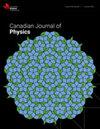Tietz势参数的公式,适用于碘钪、碘氮、氢化铷、氮和一氧化碳分子
IF 1
4区 物理与天体物理
Q3 PHYSICS, MULTIDISCIPLINARY
引用次数: 1
摘要
Tietz势在双原子分子的振动态研究中有许多应用,特别是在振动的量子力学研究中。Tietz势有多种形式,其中一种形式具有光谱拟合的四个参数。Tietz势的光谱拟合参数为Tietz势平衡键长、Tietz势深度、电位宽度和控制这些值的参数与井深的比值。本工作的重点是利用统计力学的一些原理,在光谱拟合的四个参数之间找到一个公式。根据导出的公式,讨论了Tietz势相互作用平衡键长随绝对温度的变化关系。在此基础上,Tietz势相互作用的平衡键长随绝对温度的变化缓慢。此外,Tietz势的平衡键长随体系粒子半径呈线性变化。同时,Tietz势的平衡键长随Tietz势深度、Tietz势宽度参数和Tietz势第四参数的变化而变化。Tietz相互作用的公式适用于五种不同的二聚体或分子。考虑的五种分子是氮二聚体、碘钪二聚体、碘氮二聚体、氢化铷二聚体和一氧化碳分子。一般发现,在不同的绝对温度区间内,Tietz势相互作用值的平衡键长在1 ~ 5埃之间变化。此外,还发现碘钪二聚体的Tietz势相互作用平衡键长最大,而一氧化碳二聚体的Tietz势相互作用平衡键长最小。本文章由计算机程序翻译,如有差异,请以英文原文为准。
A formula of Tietz potential parameters and applying for scandium iodine, nitrogen iodine, rubidium hydride, nitrogen, and carbon monoxide molecules
Tietz potential has several applications in the study of diatomic molecules in the discussing of vibrational states, especially, in the quantum mechanics studies of the oscillations. Tietz potential has multiple forms, one of the Tietz potential forms has four parameters of the spectroscopic fitting. The spectroscopic fitting parameters of the Tietz potential are the Tietz potential equilibrium bond length, the Tietz potential depth, the width of the potential, and the parameter which controls the values as ratio of the depth of the well. This work focuses on finding a formula between the four parameters of the spectroscopic fitting employing some of principles of the statistical mechanics. Based on the derived formula, we discuss the relationship of the equilibrium bond length of Tietz potential interaction as function to the absolute temperature. Based on this discussion, the equilibrium bond length of Tietz potential interaction varies slowly with absolute temperature. Besides, equilibrium bond length of Tietz potential varies linearly with the radius of the particles of the system. Also, the equilibrium bond length of Tietz potential varies with the Tietz potential depth, the width parameter of Tietz potential, and the fourth parameter of the Tietz potential. The formula of the Tietz interaction is applied for five different dimers or molecules. The five considered molecules are Nitrogen dimer, scandium iodine dimer, nitrogen iodine dimer, rubidium hydride dimer, and carbon monoxide molecule. Generally, it is found that the equilibrium bond length of Tietz potential interaction values vary from 1 Angstrom to 5 Angstrom for different absolute temperatures intervals. Besides, it is found that the scandium iodine dimer has the largest value of the equilibrium bond length of Tietz potential interaction, while carbon monoxide dimer has the lowest value of the equilibrium bond length of Tietz potential interaction.
求助全文
通过发布文献求助,成功后即可免费获取论文全文。
去求助
来源期刊

Canadian Journal of Physics
物理-物理:综合
CiteScore
2.30
自引率
8.30%
发文量
65
审稿时长
1.7 months
期刊介绍:
The Canadian Journal of Physics publishes research articles, rapid communications, and review articles that report significant advances in research in physics, including atomic and molecular physics; condensed matter; elementary particles and fields; nuclear physics; gases, fluid dynamics, and plasmas; electromagnetism and optics; mathematical physics; interdisciplinary, classical, and applied physics; relativity and cosmology; physics education research; statistical mechanics and thermodynamics; quantum physics and quantum computing; gravitation and string theory; biophysics; aeronomy and space physics; and astrophysics.
 求助内容:
求助内容: 应助结果提醒方式:
应助结果提醒方式:


